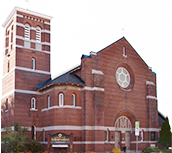Incense
Anglo-Catholic churches are known for their use of incense as part of the liturgy, and Saint Barnabas is no exception.
The use of incense is traditional, extending back through millennia of Christian worship and into the earlier traditions of Judaism. The Book of Exodus describes the instructions given to Moses to burn incense before the place of worship, and the formula for making it (Exodus 30). In Psalm 141, David asks the Lord, "Let my prayer be counted as incense before you".
Through the ages, incense has been considered both a precious gift, something rare and costly and as such a token of the best we have to offer, a symbol of reverence and awe, as well as a physical symbol of the praise and prayers of the faithful rising heavenward.
The odour of incense engages our sense of smell, thus stimulating even greater participation in the liturgy. It is also another reminder that our worship takes place out of time, in the Eternal Now of the divine. The mysterious, evocative scent tells us that we are participating in a mystery, a sacred secret, something we cannot know except through divine revelation.
Incense is made from various aromatic resins and gums obtained from trees and other plants. The incense burned at Saint Barnabas is composed of frankincense (also known as olibanum), obtained from the trunk of various trees of the genus Boswellia; myrrh, a natural resin obtained from the African Commiphora myrrha tree, and benzoin (or gum benzoin) from the bark of several species of trees in the genus Styrax. The granules are washed in essential oils and dyed with pigments.
The granules of incense are placed on red-hot charcoal tabs to enhance burning and create extra smoke. This is done in the thurible, or censer, a metal container with holes, suspended from a chain. The altar server who carries the thurible is the thurifer. The word thurible comes to us from Latin thuribulum from the root thus meaning incense, which in turn can be traced to the Ancient Greek thuos, derived from thuein, "to sacrifice".
Incense is offered at particular points in the liturgy. On entering the sanctuary, at the beginning of the Mass, the priest censes the altar to prepare it for the coming of God. Then he himself is censed by the deacon or thurifer because the priest is to become an instrument through which God acts in the Mass.
Incense may also be used at the reading of the Gospel: after the announcement of the Gospel, the book is censed left, centre and right.
At the Offertory, the bread and wine are censed because God is going to visit them and make them His habitation. This is followed by censing of the priest, of the other clergy, the choir (single or triple swing to either side) and the congregation. The congregation is censed in preparation for their Communion and as the Mystical Body of Christ through which (with the priest) God acts to consecrate the Holy Sacrifice.
At the moment of Consecration, the bread and wine, becoming the Body and Blood of Christ, are again censed by the thurifer, because God becomes present there.
Incense is also used at Solemn Evensong, which by definition is a sung celebration of vespers with use of incense, and in the Benediction of the Blessed Sacrament.

